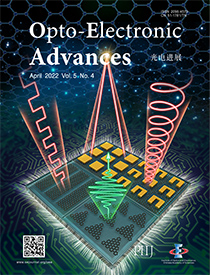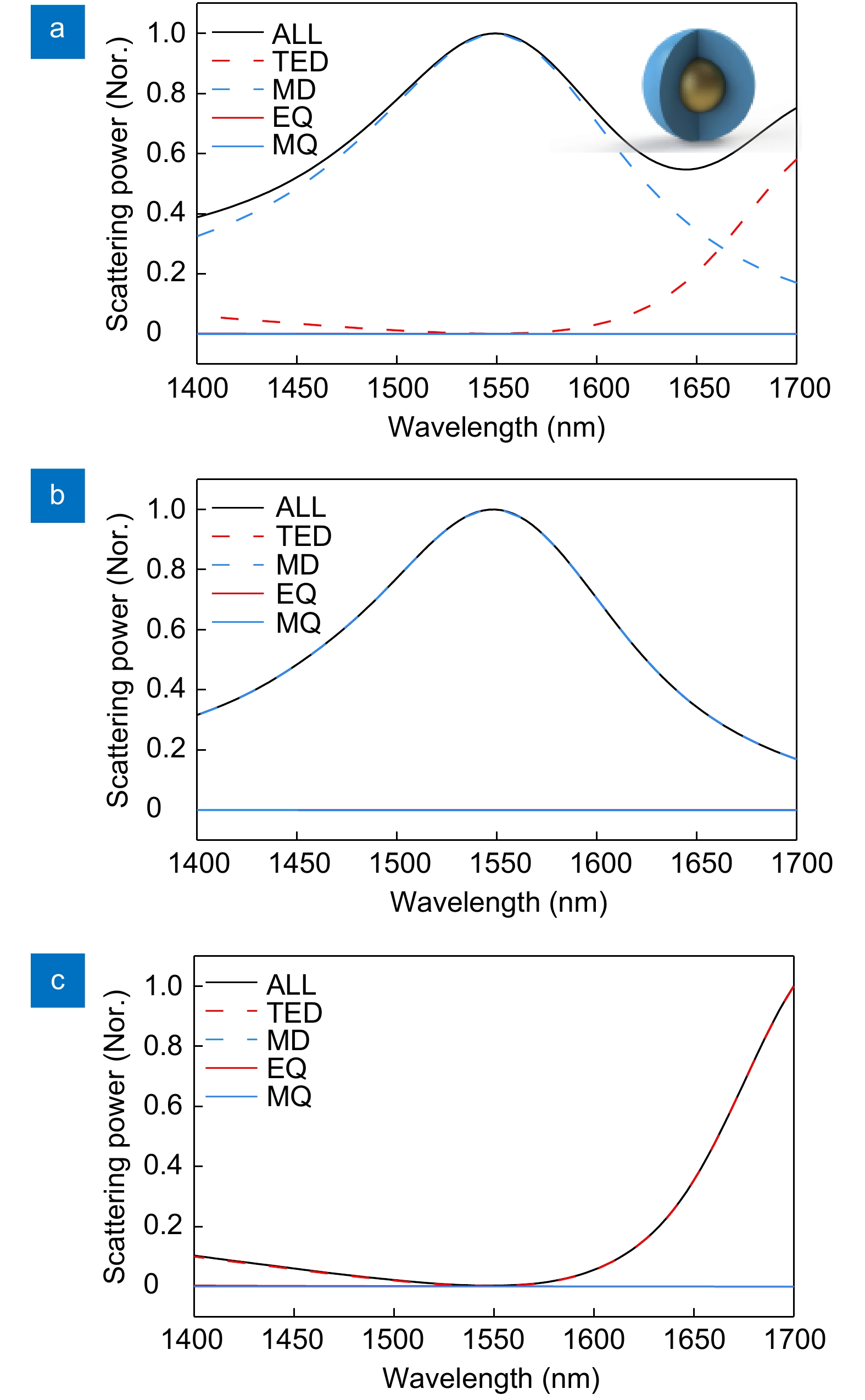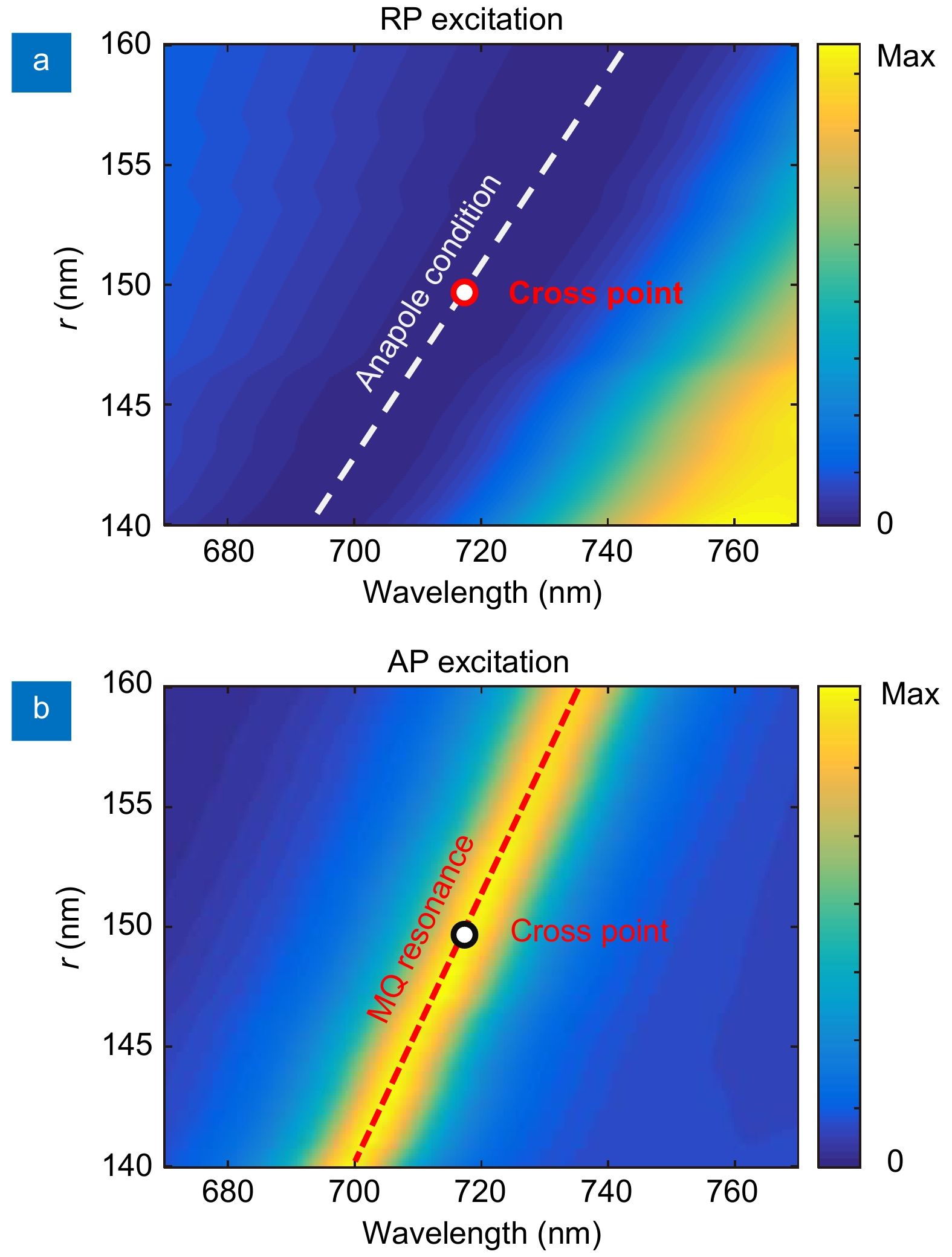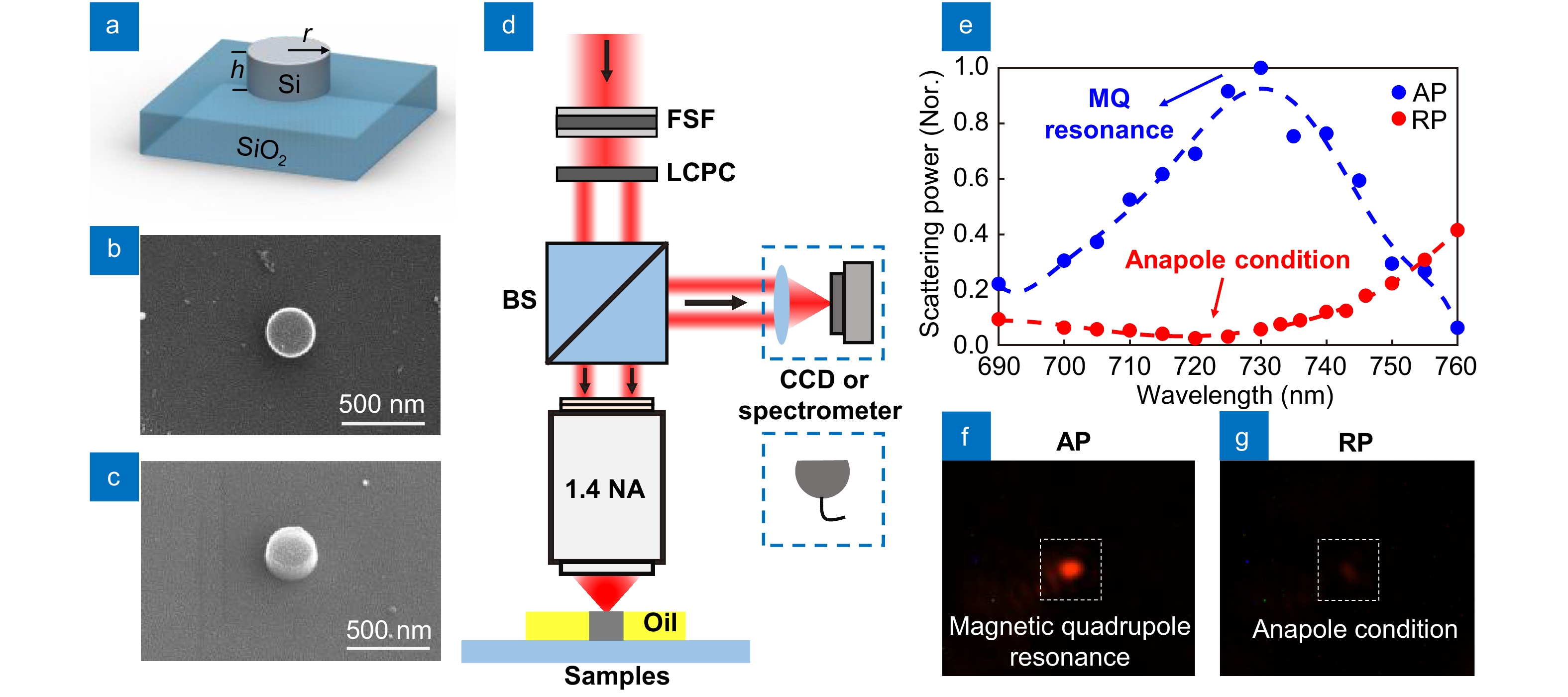| Citation: | Lu YD, Xu Y, Ouyang X, Xian MC, Cao YY et al. Cylindrical vector beams reveal radiationless anapole condition in a resonant state. Opto-Electron Adv 5, 210014 (2022). doi: 10.29026/oea.2022.210014 |
Cylindrical vector beams reveal radiationless anapole condition in a resonant state
-
Abstract
Nonscattering optical anapole condition is corresponding to the excitation of radiationless field distributions in open resonators, which offers new degrees of freedom for tailoring light-matter interaction. Conventional mechanisms for achieving such a condition relies on sophisticated manipulation of electromagnetic multipolar moments of all orders to guarantee superpositions of suppressed moment strengths at the same wavelength. In contrast, here we report on the excitation of optical radiationless anapole hidden in a resonant state of a Si nanoparticle utilizing a tightly focused radially polarized (RP) beam. The coexistence of magnetic resonant state and anapole condition at the same wavelength further enables the triggering of resonant state by a tightly focused azimuthally polarized (AP) beam whose corresponding electric multipole coefficient could be zero. As a result, high contrast inter-transition between radiationless anapole condition and ideal magnetic resonant scattering can be achieved experimentally in visible spectrum. The proposed mechanism is general which can be realized in different types of nanostructures. Our results showcase that the unique combination of structured light and structured Mie resonances could provide new degrees of freedom for tailoring light-matter interaction, which might shed new light on functional meta-optics.-
Keywords:
- anapole /
- multipole decomposition /
- all-dielectric nanoparticles
-

-
References
[1] Bohren CF, Huffman DR. Absorption and Scattering of Light by Small Particles (John Wiley & Sons, New York, 1983). [2] Kuznetsov AI, Miroshnichenko AE, Fu YH, Zhang JB, Luk’Yanchuk B. Magnetic light. Sci Rep 2, 492 (2012). doi: 10.1038/srep00492 [3] Krasnok A, Baranov D, Li HN, Miri MA, Monticone F et al. Anomalies in light scattering. Adv Opt Photonics 11, 892–951 (2019). doi: 10.1364/AOP.11.000892 [4] Afanasiev GN, Stepanovsky YP. The electromagnetic field of elementary time-dependent toroidal sources. J Phys A:Math Gen 28, 4565–4580 (1995). doi: 10.1088/0305-4470/28/16/014 [5] Fedotov VA, Rogacheva AV, Savinov V, Tsai DP, Zheludev NI. Resonant transparency and non-trivial non-radiating excitations in toroidal metamaterials. Sci Rep 3, 2967 (2013). doi: 10.1038/srep02967 [6] Miroshnichenko AE, Evlyukhin AB, Yu YF, Bakker RM, Chipouline A et al. Nonradiating anapole modes in dielectric nanoparticles. Nat Commun 6, 8069 (2015). doi: 10.1038/ncomms9069 [7] Gurvitz EA, Ladutenko KS, Dergachev PA, Evlyukhin AB, Miroshnichenko AE et al. The high-order toroidal moments and anapole states in all-dielectric photonics. Laser Photonics Rev 13, 1800266 (2019). doi: 10.1002/lpor.201800266 [8] Grinblat G, Li Y, Nielsen MP, Oulton RF, Maier SA. Enhanced third harmonic generation in single germanium nanodisks excited at the anapole mode. Nano Lett 16, 4635–4640 (2016). doi: 10.1021/acs.nanolett.6b01958 [9] Wei L, Xi Z, Bhattacharya N, Urbach HP. Excitation of the radiationless anapole mode. Optica 3, 799–802 (2016). doi: 10.1364/OPTICA.3.000799 [10] Nemkov NA, Basharin AA, Fedotov VA. Nonradiating sources, dynamic anapole, and Aharonov-Bohm effect. Phys Rev B 95, 165134 (2017). doi: 10.1103/PhysRevB.95.165134 [11] Zenin VA, Evlyukhin AB, Novikov SM, Yang YQ, Malureanu R et al. Direct amplitude-phase near-field observation of higher-order anapole states. Nano Lett 17, 7152–7159 (2017). doi: 10.1021/acs.nanolett.7b04200 [12] Gongora JST, Miroshnichenko AE, Kivshar YS, Fratalocchi A. Anapole nanolasers for mode-locking and ultrafast pulse generation. Nat Commun 8, 15535 (2017). doi: 10.1038/ncomms15535 [13] Grinblat G, Li Y, Nielsen MP, Oulton RF, Maier SA. Efficient third harmonic generation and nonlinear subwavelength imaging at a higher-order anapole mode in a single germanium nanodisk. ACS Nano 11, 953–960 (2017). doi: 10.1021/acsnano.6b07568 [14] Luk'yanchuk B, Paniagua-Domínguez R, Kuznetsov AI, Miroshnichenko AE, Kivshar YS. Hybrid anapole modes of high-index dielectric nanoparticles. Phys Rev A 95, 063820 (2017). doi: 10.1103/PhysRevA.95.063820 [15] Yang YQ, Zenin VA, Bozhevolnyi SI. Anapole-assisted strong field enhancement in individual all-dielectric nanostructures. ACS Photonics 5, 1960–1966 (2018). doi: 10.1021/acsphotonics.7b01440 [16] Parker JA, Sugimoto H, Coe B, Eggena D, Fujii M et al. Excitation of nonradiating anapoles in dielectric nanospheres. Phys Rev Lett 124, 097402 (2020). doi: 10.1103/PhysRevLett.124.097402 [17] Manna U, Sugimoto H, Eggena D, Coe B, Wang R et al. Selective excitation and enhancement of multipolar resonances in dielectric nanospheres using cylindrical vector beams. J Appl Phys 127, 033101 (2020). doi: 10.1063/1.5132791 [18] Zhang TY, Che Y, Chen K, Xu J, Xu Y et al. Anapole mediated giant photothermal nonlinearity in nanostructured silicon. Nat Commun 11, 3027 (2020). doi: 10.1038/s41467-020-16845-x [19] Li Y, Huang ZJ, Sui Z, Chen HJ, Zhang XY et al. Optical anapole mode in nanostructured lithium niobate for enhancing second harmonic generation. Nanophotonics 9, 3575–3585 (2020). doi: 10.1515/nanoph-2020-0222 [20] Sanz-Fernández C, Molezuelas-Ferreras M, Lasa-Alonso J, de Sousa N, Zambrana-Puyalto X et al. Multiple Kerker anapoles in dielectric microspheres. Laser Photonics Rev 15, 2100035 (2021). doi: 10.1002/lpor.202100035 [21] Luk'yanchuk B, Paniagua-Domínguez R, Kuznetsov AI, Miroshnichenko AE, Kivshar YS. Suppression of scattering for small dielectric particles: anapole mode and invisibility. Philos Trans R Soc A:Mathemat Phys Eng Sci 375, 20160069 (2017). [22] Baryshnikova KV, Smirnova DA, Luk'yanchuk BS, Kivshar YS. Optical anapoles: concepts and applications. Adv Opt Mater 7, 1801350 (2019). doi: 10.1002/adom.201801350 [23] Koshelev K, Favraud G, Bogdanov A, Kivshar Y, Fratalocchi A. Nonradiating photonics with resonant dielectric nanostructures. Nanophotonics 8, 725–745 (2019). doi: 10.1515/nanoph-2019-0024 [24] Yang YQ, Bozhevolnyi SI. Nonradiating anapole states in nanophotonics: from fundamentals to applications. Nanotechnology 30, 204001 (2019). doi: 10.1088/1361-6528/ab02b0 [25] Fang CZ, Yang QY, Yuan QC, Gan XT, Zhao JL et al. High-Q resonances governed by the quasi-bound states in the continuum in all-dielectric metasurfaces. Opto-Electron Adv 4, 200030 (2021). doi: 10.29026/oea.2021.200030 [26] Savinov V, Papasimakis N, Tsai DP, Zheludev NI. Optical anapoles. Commun Phys 2, 69 (2019). doi: 10.1038/s42005-019-0167-z [27] Monticone F, Sounas D, Krasnok A, Alù A. Can a nonradiating mode be externally excited? Nonscattering states versus embedded eigenstates. ACS Photonics 6, 3108–3114 (2019). doi: 10.1021/acsphotonics.9b01104 [28] Wu PC, Liao CY, Savinov V, Chung TL, Chen WT et al. Optical anapole metamaterial. ACS Nano 12, 1920–1927 (2018). doi: 10.1021/acsnano.7b08828 [29] Youngworth KS, Brown TG. Focusing of high numerical aperture cylindrical-vector beams. Opt Express 7, 77–87 (2000). doi: 10.1364/OE.7.000077 [30] Zhan QW, Leger JR. Focus shaping using cylindrical vector beams. Opt Express 10, 324–331 (2002). doi: 10.1364/OE.10.000324 [31] Gu B, Cui YP. Nonparaxial and paraxial focusing of azimuthal-variant vector beams. Opt Express 20, 17684–17694 (2012). doi: 10.1364/OE.20.017684 [32] Lou YJ, Fang YS, Ruan ZC. Optical computation of divergence operation for vector fields. Phys Rev Appl 14, 034013 (2020). doi: 10.1103/PhysRevApplied.14.034013 [33] Xian MC, Xu Y, Ouyang X, Cao YY, Lan S et al. Segmented cylindrical vector beams for massively-encoded optical data storage. Sci Bull 65, 2072–2079 (2020). doi: 10.1016/j.scib.2020.07.016 [34] Das T, Iyer PP, DeCrescent RA, Schuller JA. Beam engineering for selective and enhanced coupling to multipolar resonances. Phys Rev B 92, 241110 (2015). doi: 10.1103/PhysRevB.92.241110 [35] Woźniak P, Banzer P, Leuchs G. Selective switching of individual multipole resonances in single dielectric nanoparticles. Laser Photonics Rev 9, 231–240 (2015). doi: 10.1002/lpor.201400188 [36] Guclu C, Veysi M, Capolino F. Photoinduced magnetic nanoprobe excited by an azimuthally polarized vector beam. ACS Photonics 3, 2049–2058 (2016). doi: 10.1021/acsphotonics.6b00329 [37] Das T, Schuller JA. Dark modes and field enhancements in dielectric dimers illuminated by cylindrical vector beams. Phys Rev B 95, 201111 (2017). doi: 10.1103/PhysRevB.95.201111 [38] Manna U, Lee JH, Deng TS, Parker J, Shepherd N et al. Selective induction of optical magnetism. Nano Lett 17, 7196–7206 (2017). doi: 10.1021/acs.nanolett.7b02144 [39] Deng F, Liu HF, Panmai M, Lan S. Sharp bending and power distribution of a focused radially polarized beam by using silicon nanoparticle dimers. Opt Express 26, 20051–20062 (2018). doi: 10.1364/OE.26.020051 [40] Klimov V. Manifestation of extremely high-Q pseudo-modes in scattering of a Bessel light beam by a sphere. Opt Lett 45, 4300–4303 (2020). doi: 10.1364/OL.393570 [41] Melik-Gaykazyan EV, Kruk SS, Camacho-Morales R, Xu L, Rahmani M et al. Selective third-harmonic generation by structured light in Mie-resonant nanoparticles. ACS Photonics 5, 728–733 (2018). doi: 10.1021/acsphotonics.7b01277 [42] Koshelev K, Kruk S, Melik-Gaykazyan E, Choi JH, Bogdanov A et al. Subwavelength dielectric resonators for nonlinear nanophotonics. Science 367, 288–292 (2020). doi: 10.1126/science.aaz3985 [43] Zhan QW. Trapping metallic Rayleigh particles with radial polarization. Opt Express 12, 3377–3382 (2004). doi: 10.1364/OPEX.12.003377 [44] Zhang YQ, Shen JF, Min CJ, Jin YF, Jiang YQ et al. Nonlinearity-induced multiplexed optical trapping and manipulation with femtosecond vector beams. Nano Lett 18, 5538–5543 (2018). doi: 10.1021/acs.nanolett.8b01929 [45] Liu J, Zheng M, Xiong ZJ, Li ZY. 3D dynamic motion of a dielectric micro-sphere within optical tweezers. Opto-Electron Adv 4, 200015 (2021). doi: 10.29026/oea.2021.200015 [46] Novotny L, Beversluis MR, Youngworth KS, Brown TG. Longitudinal field modes probed by single molecules. Phys Rev Lett 86, 5251–5254 (2001). doi: 10.1103/PhysRevLett.86.5251 [47] Bauer T, Orlov S, Peschel U, Banzer P, Leuchs G. Nanointerferometric amplitude and phase reconstruction of tightly focused vector beams. Nat Photonics 8, 23–27 (2014). doi: 10.1038/nphoton.2013.289 [48] Feng TH, Xu Y, Zhang W, Miroshnichenko AE. Ideal magnetic dipole scattering. Phys Rev Lett 118, 173901 (2017). doi: 10.1103/PhysRevLett.118.173901 [49] Liu W, Zhang JF, Miroshnichenko AE. Toroidal dipole-induced transparency in core–shell nanoparticles. Laser Photonics Rev 9, 564–570 (2015). doi: 10.1002/lpor.201500102 [50] Papasimakis N, Fedotov VA, Savinov V, Raybould TA, Zheludev NI. Electromagnetic toroidal excitations in matter and free space. Nat Mater 15, 263–271 (2016). doi: 10.1038/nmat4563 [51] Kaelberer T, Fedotov VA, Papasimakis N, Tsai DP, Zheludev NI. Toroidal dipolar response in a metamaterial. Science 330, 1510–1512 (2010). doi: 10.1126/science.1197172 [52] Hoang TX, Chen XD, Sheppard CJR. Multipole theory for tight focusing of polarized light, including radially polarized and other special cases. J Opt Soc Am A 29, 32–43 (2012). doi: 10.1364/JOSAA.29.000032 -
Supplementary Information
Supplementary information for Cylindrical vector beams reveal radiationless anapole condition in a resonant state

-
Access History

Article Metrics
-
Figure 1.
Schematic of a reconfigurable optical antenna which supports the radiationless anapole condition hidden in a magnetic resonances at the same frequency. Tightly focused RP (a) or AP (b) beam is used to selectively realize the nonscattering and resonant scattering scenarios of the optical antenna.
-
Figure 2.
Numerical results of electromagnetic multipolar decomposition for the normalized scattering power of a Au core/Si shell nanoparticle under the excitation by (a) a plane wave, (b) a tightly focused AP beam and (c) a tightly focused RP beam. The radius of Au core is 86 nm while the outer radius of Si shell is 226 nm. The NA and magnification factor of the objective lens are 0.95 and 60, respectively. TED represents the contribution of toroidal and electric dipole to total scattering.
-
Figure 3.
Cartesian electromagnetic multipolar decomposition results for the scattering power of a Si nanodisk under the excitation of (a) a tightly focused RP beam and (d) a tightly focused AP beam, respectively. Multipolar moments up to quadrupole are considered. The radius of Si nanodisk is r = 150 nm while its height is h = 160 nm. The corresponding electric and magnetic field distributions at several cross sections are shown in (b), (c) and (e), (f) under the anapole condition and magnetic quadrupole (MQ) resonance, respectively. All the wavelength are 720 nm. The NA and magnification factor of the objective lens are 0.95 and 60, respectively.
-
Figure 4.
Evolution of the total scattering spectra for the Si nanodisk with different radius under the excitation of RP (a) and AP (b) beams with fixed focusing properties. The dependence of the anapole condition and MQ resonance on the radius of the Si nanodisk are outlined by dashed lines. The NA and magnification factor of the objective lens are 0.95 and 60, respectively.
-
Figure 5.
(a) A Si nanodisk fabricated on a glass substrate, where h = 160 nm and r = 150 nm indicate its height and radius. SEM images of the Si nanodisk from top (b) and side (c) views. (d) Optical setup for the back scattering spectroscopy of CVBs. FSF, Fourier spatial filter; LCPC, liquid crystal polarization converter; BS, beam splitter; CCD, charge coupled device; NA, numerical aperture. (e) Experimental measured back scattering spectra of a Si nanodisk excited by AP (blue) and RP (red) beams under the same excitation power, respectively. The dashed lines are guide to the eye. CCD images under the MQ resonance condition excited by a focused AP (f) and the anapole condition excited by a focused RP (g). The excitation wavelengths for (f) and (g) are both 735 nm.

 E-mail Alert
E-mail Alert RSS
RSS



 DownLoad:
DownLoad:






